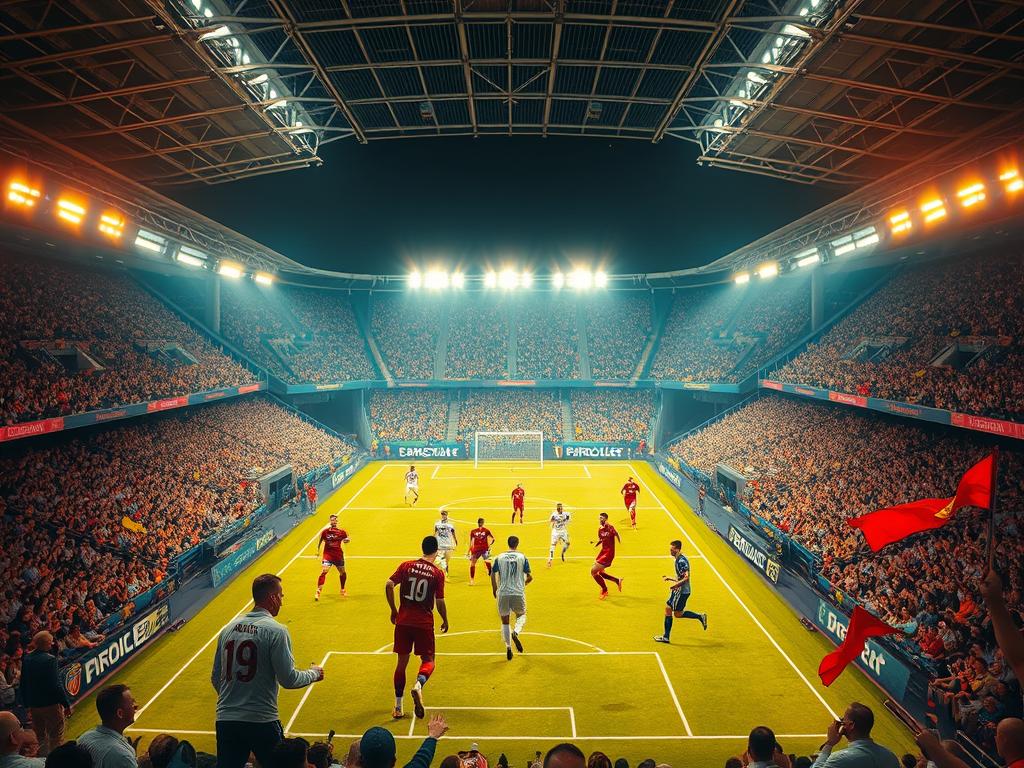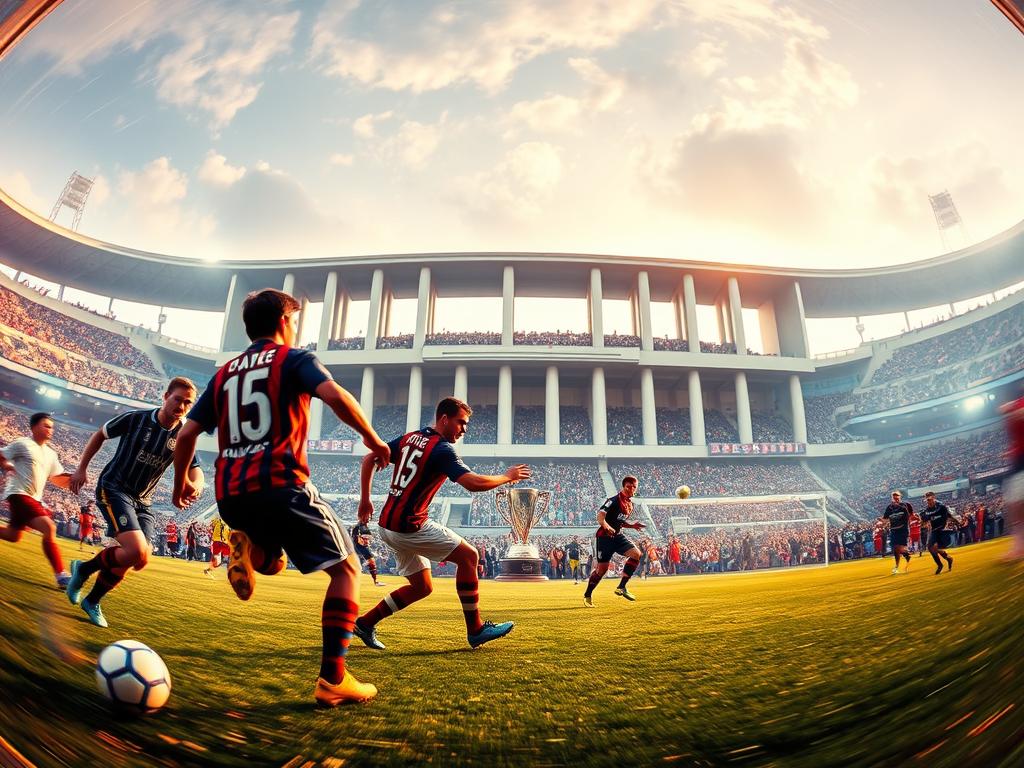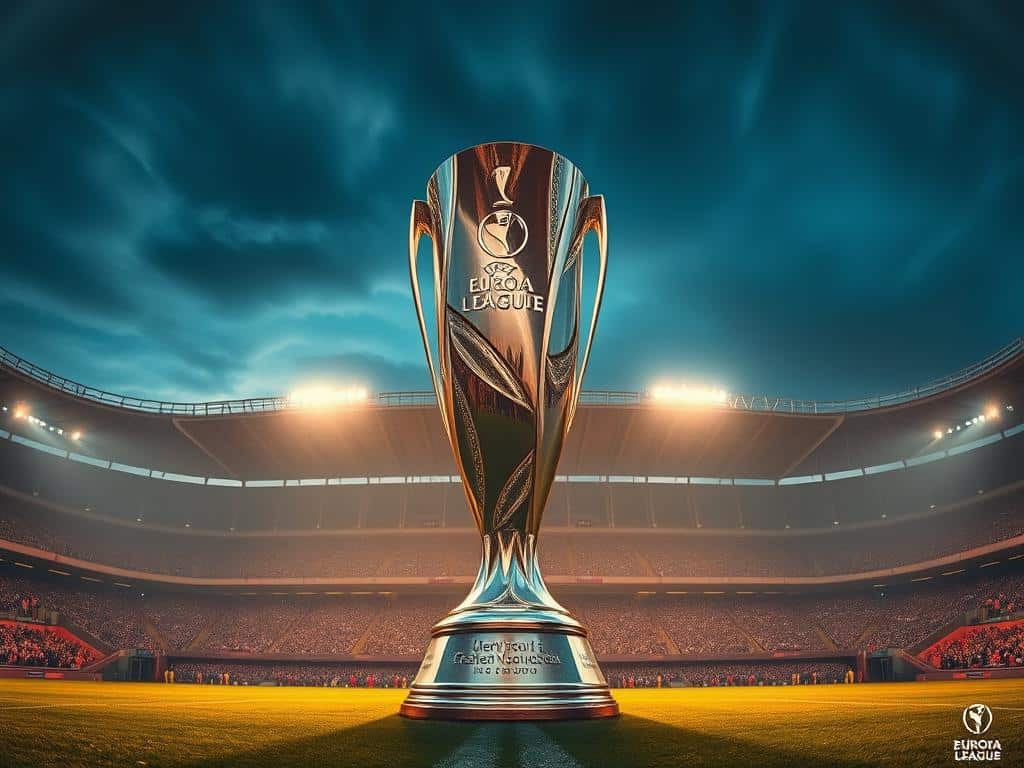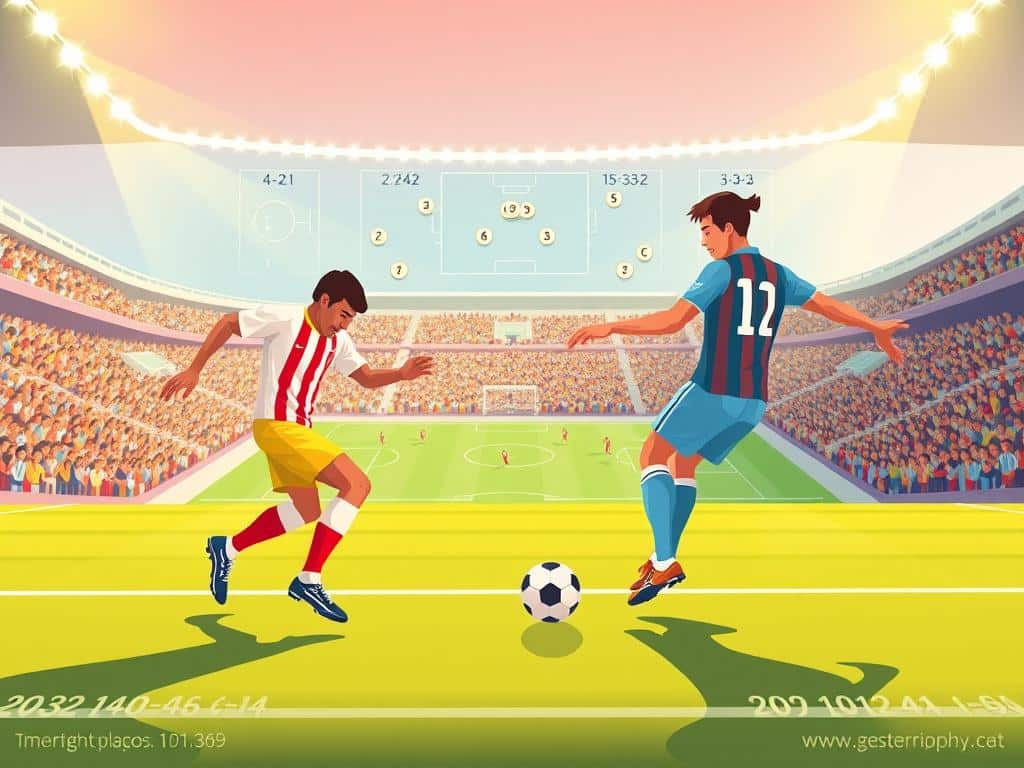Ever wondered how the FIFA World Cup crowns its champion? The final phase of this legendary tournament is where dreams come alive and underdogs become heroes. From group clashes to nail-biting knockouts, every match writes a new chapter in soccer history.
Today’s format features 32 elite squads battling through eight groups before entering single-elimination duels. But it wasn’t always this way—the competition has evolved dramatically since 1930. Whether you’re a casual fan or a die-hard supporter, knowing how this system works deepens your appreciation for the beautiful game.
Ready to dive into the mechanics behind soccer’s grandest spectacle? Let’s break down how teams progress from the opening whistle to lifting the trophy.
Introduction to the World Cup Final Stage
Every four years, nations unite for a football celebration like no other. The FIFA World Cup transforms host cities into vibrant hubs of passion, where fans from every corner of the globe gather. This tournament isn’t just about matches—it’s a cultural phenomenon.
Before the main event, 211 countries battle through qualifiers for just 32 spots. By 2026, this will expand to 48 teams, making the competition even fiercer. The journey to qualify is a marathon, testing endurance and skill.
Once the group stage begins, eight groups of four teams face off in round-robin matches. Each squad plays three games, with wins and draws deciding their fate. The energy is electric, as every pass and goal could change the standings.
Only the top two from each teams group advance to the knockout rounds. Tiebreakers—like goal difference and goals scored—add drama until the final whistle. One slip-up can send a favorite packing.
Fun fact: The inaugural 1930 event in Uruguay remains the only World Cup without qualifiers. Thirteen teams were invited directly, setting the stage for soccer’s evolution. Today, the tournament’s prestige makes it the pinnacle of soccer’s global impact.
How the World Cup Final Stage Format Has Evolved
Soccer’s biggest tournament didn’t always have its current structure—let’s explore its evolution. From uneven groups to geopolitical drama, each change reflects the sport’s growing global appeal.
The First Tournament: 1930’s Unique Structure
The first World Cup in Uruguay broke all the rules. With no qualifiers, 13 teams were split into four groups—three had three squads, one had four. No knockout rounds existed; group winners advanced directly to the semifinals.
Fun fact: The third-place playoff didn’t exist yet. The U.S. claimed bronze by default after losing in the semis.
Knockout-Only Era: 1934-1938
After 1930, FIFA switched to a pure knockout system. Sixteen teams battled in single-elimination matches, with replays deciding draws. Controversy struck in 1938 when Nazi Germany absorbed Austria’s qualified team.
Post-War Innovations: 1950-1970
The 1950 event introduced a final group instead of a championship match. Uruguay stunned Brazil 2-1 in Rio, a game still called the “Maracanazo.” By 1962, goal difference replaced playoff matches as the tiebreaker.
Expansion and Complexity: 1974-1994
The 1974 tournament added a second group phase, creating more decisive clashes. By 1982, six groups of three teams emerged in the second round. The format kept evolving, but fans craved simplicity.
Modern Standardization: 1998-2022
In 1998, FIFA settled on 32 teams and eight balanced groups—a system lasting 24 years. No more uneven brackets or confusing phases. Every match mattered equally, from opener to trophy lift.
The Current World Cup Final Stage Format
Picture this: 32 nations, eight battlegrounds, and one ultimate prize. Today’s format is a masterclass in fairness and drama, blending round-robin battles with do-or-die knockouts.
Eight groups of four teams kick off the action. Each squad plays three matches, with wins earning 3 points and draws 1. The top two teams from each group advance—no second chances.
Here’s the twist: final group games happen simultaneously. This prevents tactical collusion, like teams settling for a convenient draw. Every goal could reshuffle the standings.
Watch for the “group of death”—a bracket with multiple powerhouses. In 2014, Group D had Italy, England, and Uruguay. Only two survived.
Modern tech plays referee too. VAR reviews close offside calls, while concussion subs protect players. Even the prize money reflects the stakes: Argentina pocketed $42 million in 2022.
From the Round of 16 onward, it’s single elimination. Quarters, semis, and the final leave no room for error. One bad pass, and dreams shatter.
Group Stage Dynamics
Strategy meets survival in the tournament’s first critical phase. Eight groups of four teams clash in a round-robin battle where every point counts. Only the strongest advance, and the margins are razor-thin.
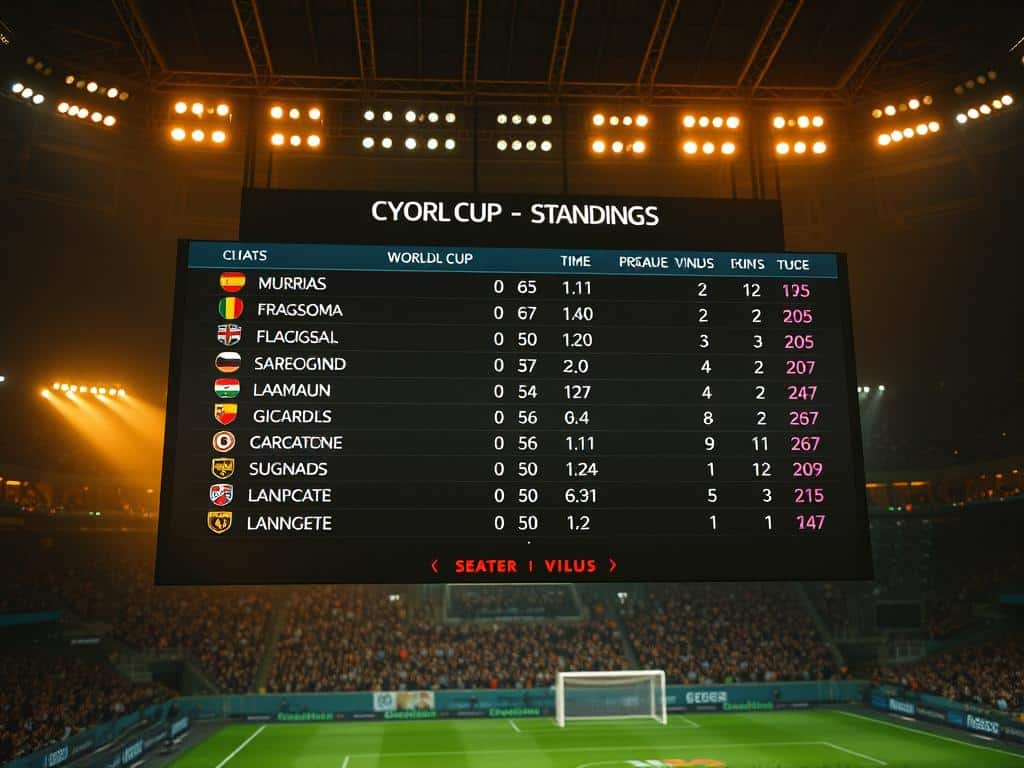
How Teams Advance from Groups
The winner group and runner-up secure knockout spots. Three points for a win, one for a draw—simple math with high stakes. Most squads need at least 4 points to progress.
Remember the USA’s 2010 miracle? A last-minute goal against Algeria sent them through on goals scored. Moments like these define the group stage drama.
Tiebreaker Rules Explained
When teams finish level on points, the tiebreakers decide their fate:
- Goal difference: Net goals matter most.
- Goals scored: Attackers get rewarded.
- Head-to-head: Who won the direct duel?
- Fair play points: Fewer yellow/red cards advance.
Fun fact: In 2018, Japan edged Senegal on fair play—a first in history. Coaches sometimes sub off aggressive players to protect their card count.
Seedings also play a hidden role. FIFA rankings place top teams in separate pots, avoiding early heavyweight clashes. Smart planning meets sheer skill.
Knockout Stage: The Road to the Final
When the knockout rounds begin, every pass and tackle carries championship consequences. Sixteen teams remain, but only one will lift the trophy. This single-elimination bracket separates contenders from pretenders with brutal efficiency.
Round of 16: First Elimination Battles
The bracket follows a simple logic: Group winners face runners-up from other groups. A1 plays B2, C1 meets D2, and so on. These matchups create instant classics—like Germany’s 4-1 thrashing of England in 2010, featuring a controversial disallowed goal.
Extra time rules add drama. If tied after 90 minutes:
- 30 additional minutes are played (15-minute halves)
- If still tied, a penalty shootout determines winners
Quarter-Finals and Semi-Finals: Narrowing the Field
Eight teams become four, then two. The pressure escalates with each round—coaches make bold substitutions, while fans bite their nails. Since 1958, only three nations have won back-to-back semifinals: Brazil, Argentina, and France.
Every game matters now. A single defensive lapse—like Croatia’s 2018 semifinal own goal—can rewrite history.
Third-Place Playoff: A Consolation Prize
Introduced in 1954, this match gives semifinal losers a final chance. Though often overlooked, it cements player legacies. Just ask Croatia’s Luka Modrić, who won the Golden Ball after their 2018 bronze.
Stats reveal the challenge: Only 20% of teams losing semifinals win this game. But for fans, it’s one last celebration before the final.
The World Cup Final: Football’s Grandest Stage
Two teams stand between dreams and destiny on football’s brightest stage. The FIFA World Cup championship isn’t just a game—it’s a global event watched by billions, where legends are born.
Remember Uruguay’s shock victory in 1950? The Maracanã Stadium hosted 200,000 heartbroken Brazilians as underdogs lifted the trophy. Today’s ceremonies still follow traditions from that historic match:
- Golden medals for winners, silver for runners-up
- The iconic trophy handover on a draped podium
- Confetti showers during national anthem performances
Modern venues like Lusail Stadium (2022) blend tradition with innovation. While Maracanã’s concrete towers whispered history, Lusail’s futuristic bowl hosted Mbappé’s hat-trick—the first in a final match since 1966.
Pre-game rituals reveal raw emotion. Watch for players mouthing lyrics during anthems—some even shed tears. These moments humanize athletes before battle commences.
Security measures reflect the stakes. Qatar spent $150 million protecting the 2022 finale, with drones and AI monitoring crowds. Germany holds the record with 8 finals reached, proving consistency matters most.
When the whistle blows, the world holds its breath. For 90 minutes, nothing else exists—just 22 players chasing immortality.
2026 and Beyond: The 48-Team Format
Get ready for the biggest shake-up in soccer history—the 2026 expansion is here! The tournament will grow to 48 squads, creating more drama and opportunities than ever before. Let’s break down how this game-changing system works.
New Group Stage Structure
Instead of eight groups, 2026 will feature groups of three teams. Sixteen brackets will each host three nations, with the top two advancing. This means no simultaneous final matches—every game becomes must-watch TV.
Pros? More countries get their moment, like rising African and Asian squads. Cons? Uneven rest periods and collusion fears loom. FIFA’s solution: strict scheduling and tiebreaker rules.
Expanded Knockout Rounds
The expanded knockout rounds will include 32 teams—double the current 16. Expect 104 total matches, up from 64. More soccer, more upsets, more unforgettable moments.
Host cities across the U.S., Canada, and Mexico will share the spotlight. From New York to Guadalajara, fans will witness history in 16 cutting-edge venues.
One thing’s certain: 2026 will redefine soccer’s grandest tournament. Whether you love tradition or crave change, this format promises fireworks.
Key Differences Between Past and Present Formats
Soccer’s ultimate tournament has transformed dramatically since its early days. What began as a 13-team invitation in 1930 now features 32 elite squads—soon expanding to 48. The evolution reflects soccer’s exploding popularity worldwide.
The world cup history shows fascinating contrasts. Uruguay’s 1950 event used a final group instead of a championship match. Today’s single-game finale creates more intense drama. Similarly, 1982’s confusing 24-team second round gave way to cleaner brackets.
Team numbers tell their own story. Early tournaments had uneven groups—some with three teams, others with four. Modern formats ensure fairness with balanced brackets. The upcoming 48-team version will create new challenges and opportunities.
Advancement rules underwent major format changes too. The 1934 straight knockout was ruthless—one bad game sent you home. Today’s group phase offers safety nets, letting squads recover from early stumbles.
Commercial growth mirrors soccer’s rise. Total prize money jumped from $4 million in 1982 to $440 million in 2022. The 1998-2022 era brought rare stability—a 24-year stretch with identical structures before the next evolution begins.
Controversies and Criticisms of Format Changes
Not every change in soccer’s biggest event has been met with cheers. From questionable expansions to scheduling headaches, the tournament format has sparked heated debates among fans and experts alike.
Remember Brazil’s 1950 heartbreak? The “Maracanazo” showed how final groups could backfire. Needing only a draw against Uruguay, Brazil’s attacking approach led to a shocking 2-1 loss—a lesson in risky formats.
The 2026 expansion to 48 teams divides opinions. Purists fear diluted quality, while progressives celebrate more nations getting their moment. With 104 matches planned, player fatigue becomes a real concern.
Collusion scandals still haunt the competition. In 1982, West Germany and Austria’s “Disgrace of Gijón” saw both teams passively play out a 1-0 result that eliminated Algeria. FIFA later changed rules to prevent such scenarios.
European and South American dominance raises eyebrows. These regions produced 95% of finalists, leaving little room for others. Yet expanding qualification slots takes time to balance competitiveness.
TV rights now influence kickoff times, sometimes prioritizing prime slots over player recovery. The 2022 Qatar event showed how commercial demands can clash with athlete welfare.
As we look ahead, one truth remains: every format change creates winners and losers. The challenge lies in preserving the magic while growing the game.
How Host Nations Influence the Format
Host nations shape soccer’s biggest event in surprising ways. From automatic bids to stadium designs, the host country leaves a lasting mark on the competition. You’ll discover how locations transform the beautiful game.
Since 1934, hosting the FIFA World Cup comes with a golden ticket—automatic qualification. This tradition gives locals a team to cheer for, like Qatar in 2022. But it also means one less spot for other hopefuls.
Switzerland changed the game in 1954 by introducing seedings. This prevented strong groups from forming early. The 2002 Japan/South Korea co-hosting broke new ground, proving tournaments could span borders.
Climate forces adaptations too. Qatar’s November-December schedule shifted the entire calendar. Stadiums must hold at least 40,000 fans for knockout matches, pushing hosts to build iconic venues.
Infrastructure costs skyrocket for host teams. Qatar spent $220 billion—more than 50 previous tournaments combined. But the payoff comes in global exposure and lasting facilities.
Altitude plays a hidden role. Mexico’s thin air in 1970 and 1986 gave home teams an edge. Now FIFA considers elevation when scheduling matches to keep things fair.
Fun fact: No European nation has ever won a tournament held outside Europe. Host advantage isn’t just about stadiums—it’s in the air, the culture, and the roaring crowds.
Memorable Moments Shaped by the Format
Soccer history is written by unforgettable upsets and near-victories. The tournament’s structure amplifies drama, turning unknowns into legends and favorites into heartbroken fans. Let’s relive the moments that define why we love this game.
Underdog Stories That Defied Odds
Imagine the shock when North Korea, a 1000-1 longshot, reached the 1966 quarterfinals. Or Costa Rica topping the 2014 “Group of Death” with Italy, England, and Uruguay. These teams proved that passion outweighs payrolls.
More recent stunners include:
- Senegal (2002): Debutants dashed to the quarterfinals, beating France along the way.
- Morocco (2022): First African squad ever to reach the semifinals, uniting continents.
Heartbreaking Near-Misses
For every triumph, there’s agony. In 1950, the USA’s 1-0 win over England—a team of amateurs defeating pros—was overshadowed by their group-stage exit. South Korea’s 2018 victory over Germany sent the defending champs home early, yet Korea fell short too.
Other gut-wrenching twists:
- Kuwait (1982): A protested goal against France altered referee protocols forever.
- Algeria (1982): Eliminated by shady tactics, sparking FIFA’s simultaneous final-match rule.
These moments remind us: in soccer, glory and grief are separated by inches—and the format magnifies both.
Why the World Cup Final Stage Captivates Billions
Nothing unites the globe quite like the FIFA World Cup’s climactic showdown. Over 1.12 billion viewers watched France battle Croatia in 2018—a number dwarfed by 2022’s 3.5 billion total engagement. This isn’t just soccer; it’s humanity’s shared heartbeat.
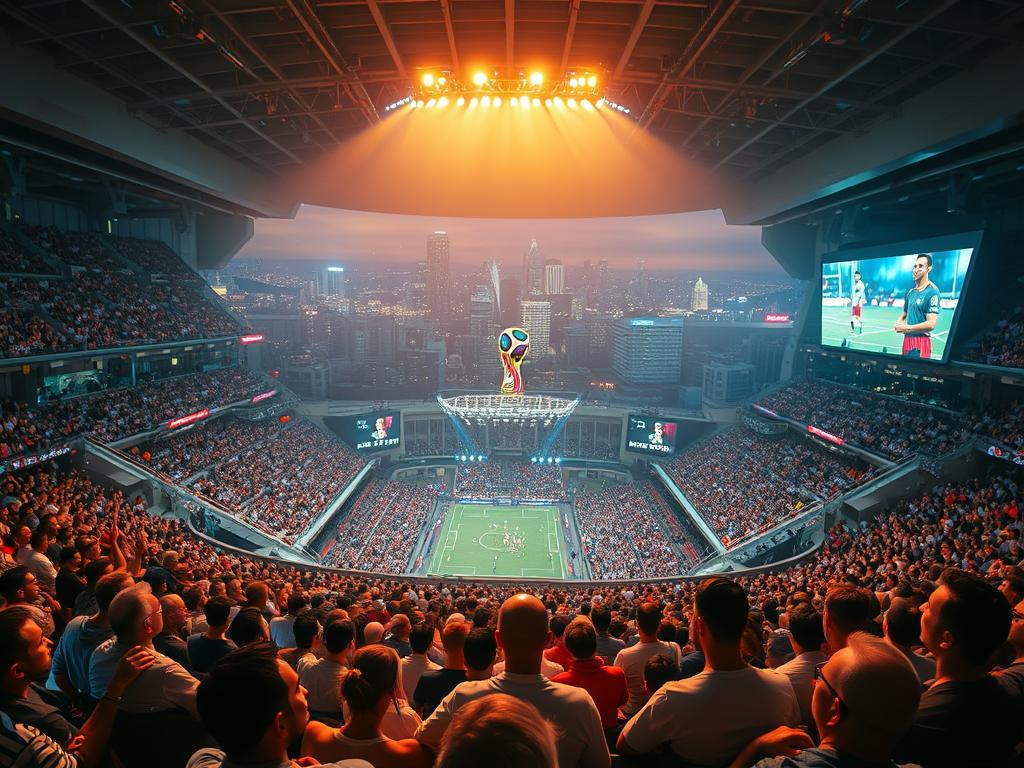
The economic impact stuns as much as the goals. Qatar’s 2022 event generated $17 billion, funding stadiums that now host community events. Hotels overflowed, and local businesses thrived during the month-long spectacle.
Cultural moments linger long after trophies are lifted. Qatar’s official anthem “Hayya Hayya” blended African rhythms with Arabic lyrics, symbolizing unity. Each match opened with 32 national anthems—a mosaic of hopes and dreams.
Digital platforms explode during the finals. Social media saw 5 billion interactions in 2022, from memes to heated debates. Fans worldwide second-guess coaches’ substitutions in real-time.
Dedication reaches extremes. Argentinian fans spent life savings traveling to Qatar, sleeping in airports to witness Messi’s triumph. For them, seeing their teams compete wasn’t optional—it was spiritual.
When the whistle blows, borders blur. Office pools in Chicago mirror street parties in Casablanca. For 90 minutes, the world speaks one language: soccer.
Your Complete World Cup Format Cheat Sheet
Need a quick guide to soccer’s biggest event? This cheat sheet breaks down everything from historic changes to modern rules. Whether you’re a new fan or a seasoned supporter, these key points will keep you in the know.
Timeline snapshot: From 13 squads in 1930 to 48 by 2026, the competition keeps evolving. Early years had uneven groups, while today’s setup balances fairness and excitement.
Advancement made simple: Top two from each group of four move to knockouts. Tiebreakers? Goal difference comes first, then goals scored. Head-to-head and fair play points decide close calls.
2026 alert: Three-team groups debut, changing how squads strategize. Every match counts—no room for slow starts.
Bookmark this page. When the tournament kicks off, you’ll have all the essentials at your fingertips.

